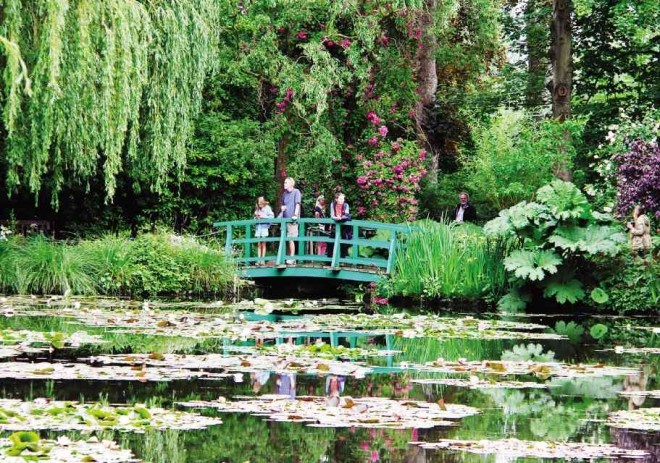
The last of the riders was already turning right at the end of the block 100 meters down the road, and there I was, still on tiptoes, struggling to straddle my bike. The seat was too high, the handlebar too wide, and my forearms tense and stiff from bearing what felt like the bike’s entire weight.
I could barely hear Anne’s encouraging words behind me. Panic had taken over my body—I couldn’t get on the bike, much less pedal ahead.
This isn’t working, I thought, they’ll leave us behind! It was a crisp morning in June, but I felt hot under the flimsy silk scarf I had belatedly tied around my neck as we left the apartment in Paris, defying what turned out to be a false sunshiny weather forecast.
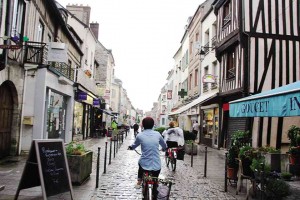
I must have been out of my mind to think that “it’s like riding a bike” was exactly that, when I agreed to visit Monet’s house and garden in Giverny outside of Paris on a bike. Not only was I out of shape, I couldn’t even recall the last time I was on two wheels.
On top of that, the standard bike used by the tour company was too big for petite, 5-foot me! Anne may have been as unfit as I was, but at least she used to ride competitively, and she actually owns her own bike, albeit rusting in storage somewhere.
Merry mix
There were over 40 of us who converged on platform 22 at Gare St. Lazare that morning for Fat Tire Bike Tours’ visit of the famous gardens and home of one of the founders of the French Impressionist school, Claude Monet. We were a merry mix of pensioners, mothers and daughters, couples, vacationers of all ages and shapes, mostly Americans and Australians. Anne and I were the only Asians.
We had belatedly signed up for the tour, while on a layover in Dubai three days earlier, as Anne’s research found that last-minute bookings have highly discounted tickets. She was right.
The itinerary was: Take the train to the town of Vernon; buy supplies in the village for a picnic lunch by the Seine; pick up our bikes and stop for lunch; then make our way to Giverny, roughly 10 km round-trip. Easy peasy. I’ve covered longer distances when I used to run. The morning was looking well: A longtime Monet fan, I was finally about to see in living color the famous gardens that were the subject of many of his famous works!
Our group was split in half, and we joined the one led by a guide named David Costigan, or Costi, a Kiwi who used to teach English in South Korea before the charms of a French girl lured him across continents. On the 40-minute train ride, Costi regaled us with stories about Monet, hinting at some juicier details to be shared later in the day.
He had with him a few books, with visual guides suggesting what to expect during the tour, images of Monet’s famous works, including some from the artist’s series on Gare St. Lazare, the train station where we just came from.
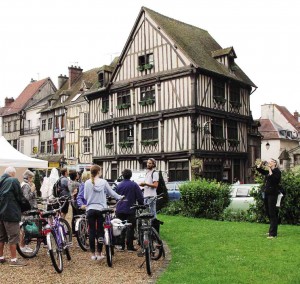
It began to drizzle steadily by the time we reached Vernon, but tours run rain or shine. Everyone was a trouper.
Costi led us to the commercial center of the small village, the street signs of which had replicas of Monet’s paintings. The guide pointed out where we ought to be headed: the local fromagerie (cheese shop), the boulangerie (bakery), the charcuterie (deli), the fruit stand.
Orchards
The Normandy region where Vernon is located is known for its orchards, so Costi suggested we try the ciders (made of apples), or the tarts and pies made with fruits.
“Forget the macaron; you can have those in Paris,” he added.
“If you want to try something before you buy, say, ‘Goute, s’il vous plait? (May I taste, please?)” He added in warning, “Remember that too much goute will end up in a big boote (booty)!”
The fromagerie was small, but it had every imaginable shape and variety of cheese that I could’ve goute-d all day! There was a period last year when I got so obsessed with cheese I had some after each meal.
This time, I was content to just feast my eyes, so Anne and I settled for small wheels of Camembert and chevre, remembering Costi’s warning about smelly bags bearing funky cheese.
We also got slivers of Costi’s recommended saucisson (dry cured sausage) and chorizo from the friendly shopkeeper who didn’t speak English. (We got by somehow with sign language. I had memorized a few French phrases, but when I needed to say them, my tongue got stage fright! We found that a simple “Bonjour!” with a smile invariably received a reply that was just as warm. Contrary to reputation, the French, Parisians included, can be friendly.)
Not far from the market, Costi led us to a garage where we were each given our bikes, and were taught how to adjust the seats, the gears, attach the basket. I should’ve paid attention more, I later rued.
Each bike had a name. “I never thought I’ll get to say this: I’m riding ’Tom Brady!’” said a woman from Ohio. “Call me Gisele,” she added, referring to the supermodel wife of the football star. No thanks to the debacle that ensued, I forgot what mine was called.
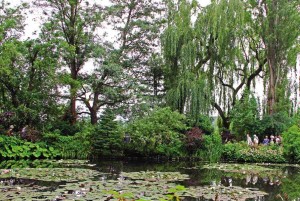
Warning
I don’t know how many times I had almost taken a spill or how many minutes had passed before, finally, I was easily pedaling behind the rest of the pack.
Along the way, we passed 15th-century houses, and a stunning Gothic church from the 11th century. Costi told us to dominate an entire lane and ride close to the pack to deter aggressive motorists from running us off the road.
The implication of that warning didn’t quite sink in until I saw cars coming from every direction! It brought back terrifying childhood memories riding alongside 10-wheeler trucks and buses on the highway back home up north; I was never a confident rider.
And true enough, within minutes we were on Vernon’s main highway, on the vast Clemenceau bridge, among big trucks no different from my childhood’s. I could actually die here, I thought.
It was a short ride, maybe 2 km, to the picnic spot, and the other riders had already occupied the tarp Costi and his two assistants had laid out on the damp grass, just beneath an old mill straddling two piers, the remainder of a centuries-old bridge on the river Seine.
We settled on a picnic table nearby and watched a flock of ducks swim on the river while we sipped our cider; I was parched. We made sandwiches with the baguette; everything tasted good. The Camembert smelled authentic. The tarte aux fraises had a divine buttery crust and sweet, plump strawberries.
I spotted the kids and their bikes in the other group across the park; those would’ve been a better fit for my size, I thought ruefully.
By this time, Costi had assessed the group and, though he didn’t say it out loud, determined the turtles: moi and an American grandma who was traveling with her daughter and teen granddaughter. Granny wasn’t bailing, then neither was I, even if it killed me. If a septuagenarian can do it…
To be fair, even I knew that the course was easy. The roads were wide and smooth, hardly any climbs or steep drops. Fat Tires’ ride-as-a-pack approach worked: Motorists yielded each time. My only issue was that the bike was too big for my size.
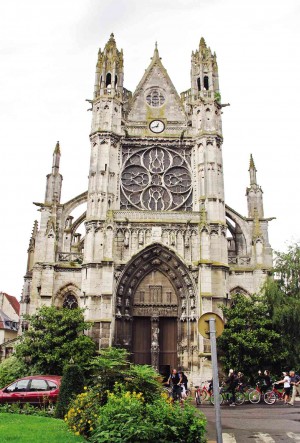
Costi tried to fix this by making me and another girl switch bikes; hers had a narrower handlebar. It helped a little, as I had a smoother ride approaching Giverny. At one point Granny took a spill, but she was a toughie, that one.
Soap-opera life
Monet spotted Giverny from a train coming from Vernon while his family was living in Poissy, a place that is said to have made him miserable. They moved to a rented house in the quiet village in 1883, accompanied by Alice Hoschede, who would become his second wife. Monet’s first wife, Camille, the subject of some of his famous works, including “The Woman in the Green Dress,” and the mother of his two sons, died in 1879, aged 32, of uterine cancer.
As we surveyed Monet’s and his clan’s tomb at the church cemetery in Giverny, we understood what Costi was hinting at earlier in that day: Monet led a life worthy of a soap opera.
“Very ‘Days of Our Lives,’” quipped one.
Monet wasn’t as successful an artist as he was later in life—the Impressionists were rebels, and the French, who were steeped in tradition, didn’t take to the Impressionists right away.
In fact, Monet’s early fans were the affluent Americans. It was only when Monet and his contemporaries (Pierre-Auguste Renoir, Edouard Manet, et al.) were getting attention abroad that the French gave notice. (Renoir and Monet were such good friends they used to paint side-by-side. Costi showed us visual comparisons of their works during such sessions.)
Monet later had wealthy patrons, including a merchant named Ernest Hoschede, who invited Monet’s family to live with him and his wife Alice and their children in his lavish home southeast of Paris. It is believed that Monet began having an affair with Alice during this period.
When Hoschede lost his fortune, he left to escape his debtors, leaving behind his family, whom Monet in turn invited to live with his own in Vetheuil.
Monet’s personal life was quite scandalous at the time. He married Camille, his one-time model, only when their first son, Jean, was already 5 years old. When she got wind of his affair with Alice, she had an abortion to spite him, one that, accounts say, caused her grave health complications that would lead to her demise.
It is also speculated that the youngest of Alice’s children was actually Monet’s, and Costi pointed out the likeness of the two boys in a couple of portraits at the Monet house, one of Michel’s, the painter’s younger son, and the other Alice’s youngest.
Vast gardens
Monet’s large family—Alice, her six kids and his two sons—filled the rambling Giverny farmhouse, which he later bought. It had an orchard and a barn that he used as a studio, and the vast gardens he had had planted based on color, including the water lilies, one of his best-known subjects.
It looks somewhat like a messy jungle, with Japanese bridges, bamboos and old willow trees reflecting on the lily pond. But the landscape was, in fact, Monet’s evolving project of careful composition, a wild explosion of colors, best seen in the spring and summer.
It was overrun with tourists in early June, with little Monet wannabes on a class trip hunched on benches attempting to draw the gardens, and even an Asian bride in her wedding tulle and lace on a pictorial.
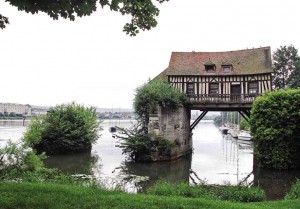
Most of the paintings in the Monet home, however, are replicas, save for the Japanese woodblock prints, which the painter collected. So it’s best to complement this tour with a trip to Musee d’Orsay or Musee l’Orangerie in Paris, where his famous water lilies series like “Nympheas” are.
Monet married Alice in 1892 after her husband died. Alice’s daughter, Blanche, would marry Monet’s son Jean, and it was she who would take care of Monet later in his life. She was also his assistant and pupil.
When Monet died in the winter of 1926, he left his estate, including the Monet home and garden, to his surviving son Michel, who bequeathed it to the French Academy of Fine Arts in 1966. Monet shares his tomb with eight family members, including Alice, but not Camille.
The ride back to Vernon was not pain-free, but I was only glad that we—I—made it before the last train to Paris pulled away from the station.
And all the while, I was thinking, this is just the kind of thing you write home about.













































